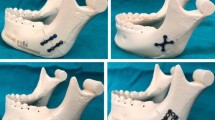Abstract
Purpose
Patient-specific mandible reconstruction plates may be pre-bent to facilitate the surgical procedure. A method using transfer keys (TK) for repositioning pre-bent plates was compared with the standard method on mandibular models to evaluate its feasibility.
Method
Ten mandible models were used to pre-bend reconstruction plates. After plate fixing on the models, TK were fabricated. Plates and TK were removed and segmental resections were performed. The plates were replaced on the models by the standard method of determining the plate position using previous screw holes. Plates were removed and then relocated by use of the TK. To compare the accuracy of both methods, the distances between four corresponding points of the condyles and the mandibular rami were measured.
Results
The mean deviation of the absolute values from the initial values for the models between the condyles and the rami was 0.964 mm for the standard method and 0.821 mm for the TK method. To determine whether there was enlargement or shrinkage between the rami or the condyles, we analysed the relative values of the data. For the standard method, the mean deviation from the initial values was +0.178 mm; for the TK method, it was +0.080 mm. In both cases, the differences were not significant.
Conclusion
Pre-bent reconstruction plates using patient-specific 3D models can be useful in mandible reconstruction. The TK method was tested in vitro and shown to be as accurate as the standard method. The TK method may shorten the procedure and may be useful for secondary cases and cases where the pathology involves the outer corte of the mandible.
Similar content being viewed by others
References
Saunders JR, Hirata RM, Jaques DA (1990) Definitive mandibular replacement using reconstruction plates. Am J Surg 160: 387–389
Buchbinder D, Urken ML, Vickery C, Weinberg H, Biller HF (1991) Bone contouring and fixation in functional, primary microvascular mandibular reconstruction. Head Neck 13: 191–199
Steinberg MJ, Collins SL (1998) A simple fixation device to preserve anatomic position during reconstruction of mandibular defects. Laryngoscope 108: 448–451
Vural E, Yuen JC (2007) Combining use of resin models with external fixation in mandibular reconstruction. Arch Otolaryngol Head Neck Surg 133: 603–607
Binder WJ (2008) Custom-designed facial implants. Facial Plast Surg Clin North Am 16: 133–146
Eisele DW, Richtsmeier WJ, Graybeal JC, Koch WM, Zinreich SJ (1994) Threedimensional models for head and neck tumor treatment planning. Laryngoscope 104: 433–439
Kernan BT, Wimsatt JA (2000) Use of a stereolithography model for accurate, preoperative adaptation of a reconstruction plate. J Oral Maxillofac Surg 58: 349–351
Salgueiro M, Stevens M (2010) Experience with the use of prebent paltes for the reconstruction of mandibular defects. Craniomaxillofac Trauma Reconstr 3: 201–208
Toro C, Robiony M, Costa M, Zerman N, Politi M (2007) Feasibility of preoperative planning using anatomical facsimile models for mandibular reconstruction. Head Face Med 15(3): 5
Ung F, Rocco JW, Deschler DG (2002) Temporary intraoperative external fixation in mandibular reconstruction. Laryngoscope 112: 1569–1573
Ameerally PJ, Hollows P (2004) Use of an external fixator to stabilise the proximal mandibular segments during reconstruction. Br J Oral Maxillofac Surg 42: 354–356
Louis PJ, Fernandes R (2001) Temporary stabilization of mandible with external fixation device. J Oral Maxillofac Surg 59: 1374–1375
Mohindra A, Blanco-Guzman MM (2009) Temporay mandibular stabilization during reconstruction: a alternative technique. Br J Oral Maxillofac Surg 47: 399–400
Reece GP, Martin JW, Lemon JC, Jacob RF (1993) Mandible fragment fixation during reconstruction: the splint-and-plate technique. Ann Plast Surg 31: 128–133
Shippert R (2005) A study of time-dependent operating room fees and how to save $1,00,000 by using time-saving products. Am J Cosmet Surg 22: 25–34
Kermer C, Rasse M, Lagogiannis G, Undt G, Wagner A, Millesi W (1998) Colour stereolithography for planning complex maxillofacial tumour surgery. J Craniomaxillofac Surg 26: 360–362
Author information
Authors and Affiliations
Corresponding author
Rights and permissions
About this article
Cite this article
Wilde, F., Plail, M., Riese, C. et al. Mandible reconstruction with patient-specific pre-bent reconstruction plates: comparison of a transfer key method to the standard method—results of an in vitro study. Int J CARS 7, 57–63 (2012). https://doi.org/10.1007/s11548-011-0599-8
Received:
Accepted:
Published:
Issue Date:
DOI: https://doi.org/10.1007/s11548-011-0599-8




